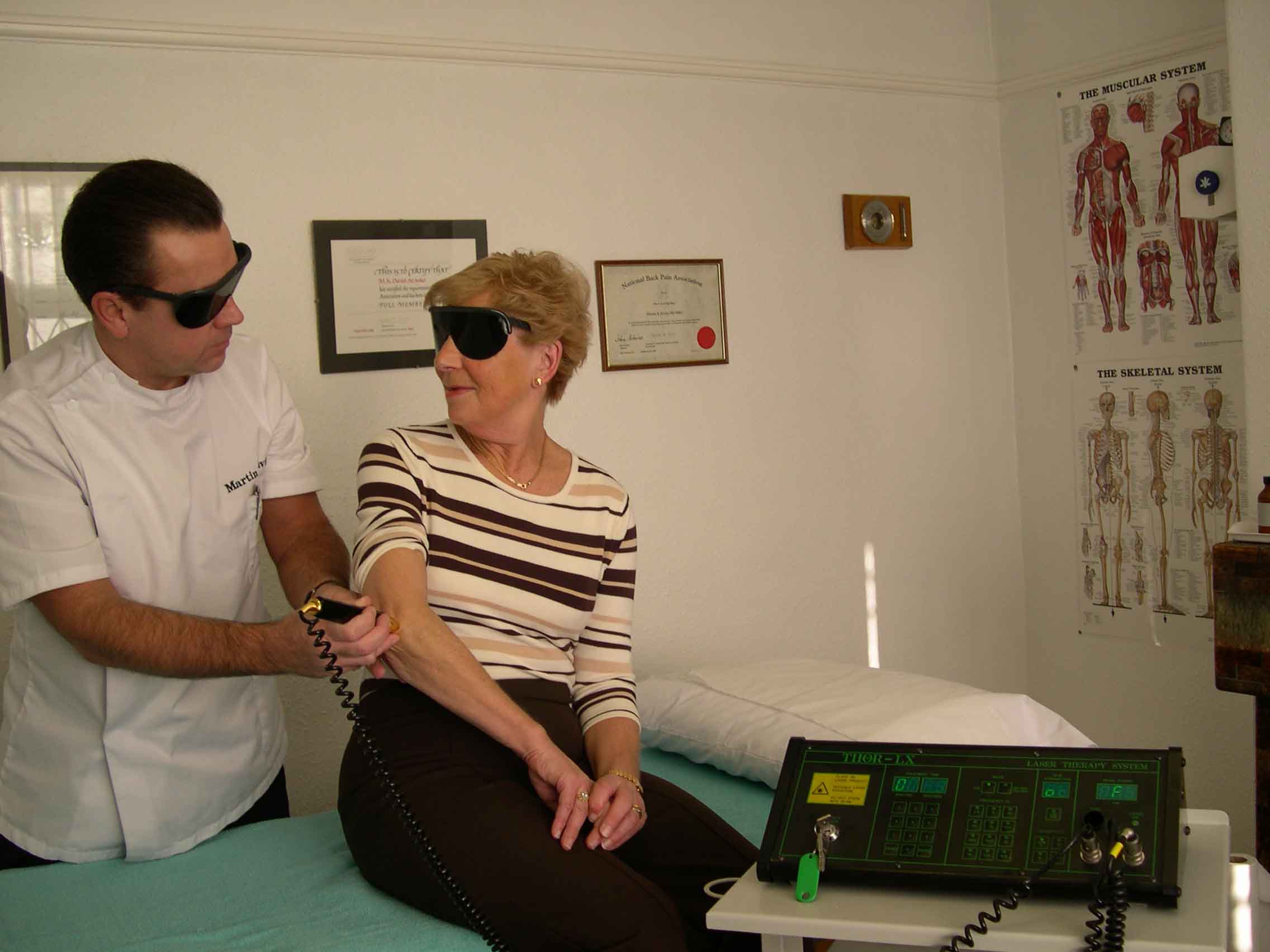Here at Hazel grove Osteopaths in Stockport we have invested in one of the top of the range Lasers for the treatment of musculoskeletal injuries and arthritic conditions!
Commonly these lasers made by Thor, the leading name in phototherapy medicine can cost £12,000 but this therapy is offered*free *as an adjunct to our Osteopathic patients!
What is Cold Laser Therapy?
Cold Laser Therapy is another name for photobiomodulation or Low Level Laser Therapy (LLLT).
It is a light therapy using lasers to improve tissue repair, reduce pain and inflammation wherever the beam is applied. Treatments take about 5‑10 minutes and can be applied two or more times a week.
Cold Laser has been used for many years on sports injuries, arthritic joints, nerve pain situations as well as back, neck, knee, hip and shoulder pain. Over 300 randomised clinical trials have been published on laser therapy, half of which are on pain.
Scientific evidence confirms that lower intensity 3B lasers are more effective for inflammation and healing. High intensity is however good for analgesia so THOR lasers have both high and low intensity lasers / LEDs.
Cold Laser Therapy Advantages
Cold laser therapy is a newer procedure with several advantages. Cold laser therapy is a non‑invasive procedure, meaning that it does not require a surgical incision.
This means that there is no prolonged recovery time.
Laser therapy also does not involve taking any medications, and many patients prefer to avoid taking medications. Studies have so far found that cold laser therapy does not have serious side effects when used properly by a trained therapist.
Low Level Laser (LLLT) “regenerates teeth
Posted on 10 June 2014 by James Carroll thor news TV, radio and newspapers all over the world got very excited last week reporting that “laser regenerates teeth” following a Harvard study. The study showed that LLLT stimulates the stem cells resident in the tooth pulp to form dentin (for details click below). This is the highest profile announcement for any LLLT paper ever and will add significant awareness and credibility for everyone in the field. Congratulations and huge thanks to the author Dr Praveen Arany B.D.S., M.D.S., M.M.Sc., Ph.D. who is now a Clinical Investigator at NIH.see reports here NHS, Times of India, BBC, NBC, CBS, Daily MailPhotoactivation of Endogenous Latent Transforming Growth Factor‑beta1 Directs Dental Stem Cell Differentiation for Regeneration.Arany PR, Cho A, Hunt TD, Sidhu G, Shin K, Hahm E, Huang GX, Weaver J, Chen AC, Padwa BL, Hamblin MR, Barcellos‑Hoff MH, Kulkarni AB, J Mooney DHarvard School of Engineering and Applied Sciences, Cambridge, MA 02138, USA.Rapid advancements in the field of stem cell biology have led to many current efforts to exploit stem cells as therapeutic agents in regenerative medicine. However, current ex vivo cell manipulations common to most regenerative approaches create a variety of technical and regulatory hurdles to their clinical translation, and even simpler approaches that use exogenous factors to differentiate tissue‑resident stem cells carry significant off‑target side effects. We show that non‑ionizing, low‑power laser (LPL) treatment can instead be used as a minimally invasive tool to activate an endogenous latent growth factor complex, transforming growth factor‑beta1 (TGF‑beta1), that subsequently differentiates host stem cells to promote tissue regeneration. LPL treatment induced reactive oxygen species (ROS) in a dose‑dependent manner, which, in turn, activated latent TGF‑beta1 (LTGF‑beta1) via a specific methionine residue (at position 253 on LAP). Laser‑activated TGF‑beta1 was capable of differentiating human dental stem cells in vitro. Further, an in vivo pulp capping model in rat teeth demonstrated significant increase in dentin regeneration after LPL treatment. These in vivo effects were abrogated in TGF‑beta receptor II (TGF‑betaRII) conditional knockout
Laser Therapy
Laser therapy has primarily been shown useful in the short‑term treatment of acute pain caused by rheumatoid arthritis, osteoarthritis, tendinopathy, and chronic joint disorders.
It has also been useful in the treatment of both acute and chronic neck pain and it has been suggested for decades that LLLT could be useful in speeding wound healing.
A Cochrane review found evidence that low‑level laser therapy may help in frozen shoulders.
How it works
The science from Wikipedia:‑
“Laser therapy reduces pain related to inflammation by lowering, in a dose‑dependent manner, levels of prostaglandin E2, prostaglandin‑endoperoxide synthase 2, interleukin 1‑beta, tumor necrosis factor‑alpha, the cellular influx of neutrophil granulocytes, oxidative stress, edema, and bleeding. The appropriate dose appears to be between 0.3 and 19 joules per square centimetre. Another mechanism may be related to stimulation of mitochondrion to increase the production of adenosine triphosphate resulting in an increase in reactive oxygen species, which influences redox signalling, affecting intracellular homeostasis or the proliferation of cells. The final enzyme in the production of ATP by the mitochondria, cytochrome c oxidase, does appear to accept energy from laser‑level lights, making it a possible candidate for mediating the properties of laser therapy.
The effects of LLLT appear to be limited to a specified set of wavelengths of laser,[4] and though more research is required to determine the ideal wavelengths, durations of treatment, dose and location of treatment (specifically whether LLLT is more appropriately used over nerves versus joints).[2] Administering LLLT below the dose range does not appear to be effective.[5] The factors of wavelength, effective dose, dose‑rate effects, beam penetration, the role of coherence, and pulses (peak power and repetition rates) are still poorly understood in the clinical setting. The typical laser average power is in the range of 1‑500 mW; some high‑peak‑power, short‑pulse‑width devices are in the range of 1‑100 W with typical pulse‑widths of 200 ns. The typical average beam irradiance then is 10 mW/cm2 ‑ 5 W/cm2. The typical wavelength is in the range 600‑1000 nm (red to near infrared), but some research has been done and products outside of this range are available.”


